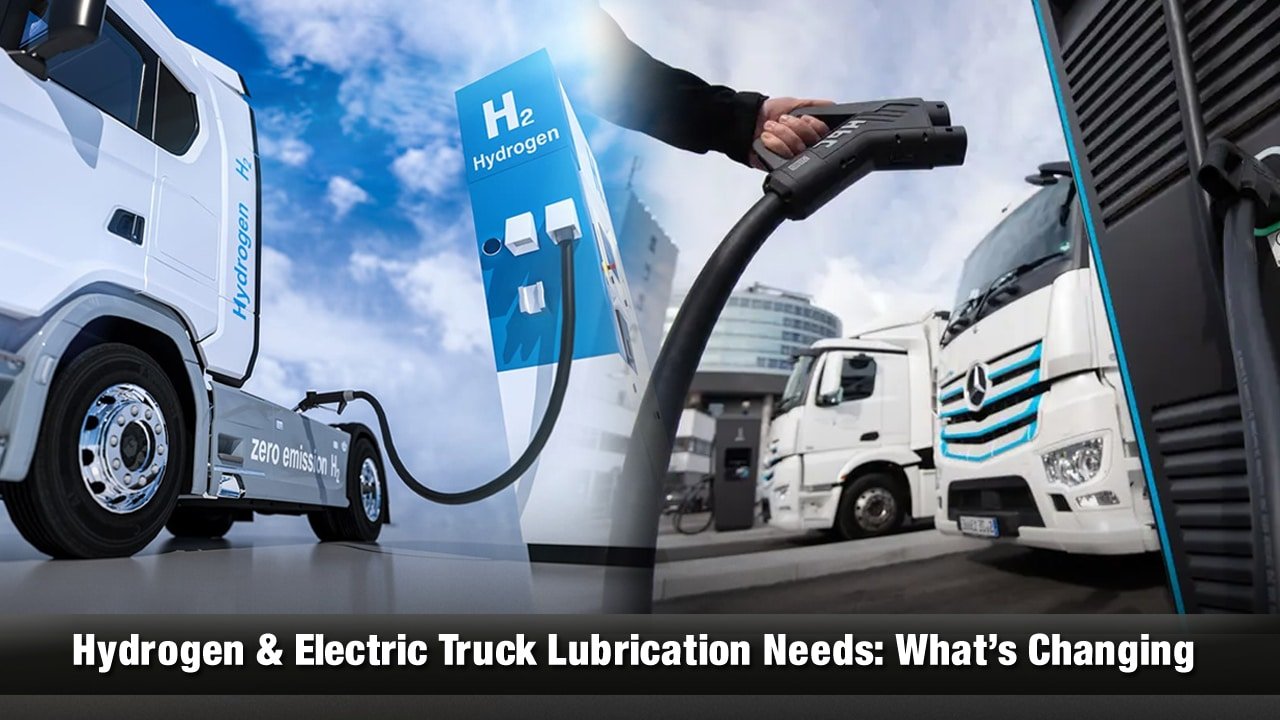
The trucking world is shifting fast. With stricter emission rules on the horizon, hydrogen fuel cells and electric trucks are leading the move away from diesel. While most talk is about range and charging, there’s a hidden hero in this transition — Lubrication.
At Fubex Lubricants, we provide premium engine oils designed for all types of engines. Enjoy fast delivery, a price match guarantee, and hassle-free returns. Which oil is right for your vehicle? Call us at +971 50 544 9614 — our friendly experts are always ready to help!
These next-gen trucks don’t use motor oil the way diesel engines do, but they still rely on special fluids and greases to stay cool, reduce wear, and run safely. In this blog, we’ll look at how lubrication needs are changing and what it means for the future of heavy-duty fleets.
Future of Heavy-Duty Vehicles: Hydrogen Fuel Cell vs. Electric Trucks
Heavy-duty vehicles (HDVs) are responsible for nearly 6% of fossil CO₂ emissions in the EU. To address this, the EU Regulation on HDVs has set strict emission reduction targets for new vehicles:
- 45% by 2030
- 65% by 2035
- 90% by 2040
With these ambitious goals, traditional diesel internal combustion engines (ICEs) will no longer be enough. The transport sector now looks toward zero-emission solutions such as battery electric trucks and hydrogen fuel cell trucks. Both are emerging as the future of sustainable heavy transport—but which is better for tomorrow’s fleets?
I. Technology Overview
Both hydrogen trucks and electric trucks are powered by electric drivetrains, ensuring zero tailpipe emissions. However, their energy storage systems differ:
- Hydrogen Fuel Cell Trucks
- Generate electricity in real time using a hydrogen fuel cell.
- Hydrogen stored in tanks reacts with oxygen to produce electricity, releasing only water and heat.
- Quick refueling is done at hydrogen fueling stations.
- Electric Trucks
- Store energy in lithium-ion batteries.
- Require charging at electric charging stations.
II. Comparing Performance & Practicality
1. Driving Range
- Hydrogen Trucks: Can reach up to 1,000 km per tank, making them ideal for long-haul transport. Their performance remains stable even in extreme cold.
- Electric Trucks: Typically offer 200–500 km, depending on battery size and driving conditions.
2. Refueling & Charging Times
- Hydrogen Trucks: Refuel in 15–20 minutes, similar to diesel trucks.
- Electric Trucks: Require several hours to recharge, even with fast-charging infrastructure.
3. Payload Capacity
- Hydrogen Trucks: Lighter powertrain, allowing payloads close to traditional diesel trucks.
- Electric Trucks: Heavy batteries reduce load capacity, especially in long-haul models.
4. Operational Flexibility
- Hydrogen Trucks: Easily integrated into existing fleet operations with no significant changes to routines.
- Electric Trucks: Require route adjustments and downtime planning due to longer charging needs.
In summary:
- Hydrogen trucks excel in range, payload, and quick refueling, making them suitable for long-distance freight.
- Electric trucks work well for shorter routes and urban logistics, where charging infrastructure is accessible.
Both technologies will play a key role in achieving sustainable, zero-emission transportation.
III. Economic Implications
1. Acquisition and Maintenance Costs
Currently, hydrogen fuel cell trucks come with a higher purchase price than electric trucks. This is mainly because fuel cell technology is still new and complex. However, over time, the total cost of ownership (TCO) can balance out, as fuel cells are designed to last longer and often match the entire life cycle of the truck.
In comparison, electric trucks are more affordable upfront but can face higher long-term costs. Batteries degrade over time and usually need replacement after several years of heavy use, which increases maintenance expenses.
2. Infrastructure Costs
Building infrastructure for hydrogen remains one of the biggest challenges. Hydrogen refueling stations are costly and still limited in number. However, progress is underway. With the EU AFIR regulation requiring a hydrogen station every 200 km across key European routes, many large-scale projects are already in development. By 2030, when serial production of fuel cell electric vehicles (FCEVs) ramps up, infrastructure should expand significantly.
On the other hand, electric charging stations are already more widespread. However, installing megawatt-scale chargers for heavy-duty trucks necessitates significant upgrades to the power grid. In rural or highway areas, this can be expensive and time-consuming due to limited grid capacity.
3. Refueling Costs
At present, hydrogen fuel remains more expensive per kilometer compared to electricity. This is mainly because electrolyzers and hydrogen storage systems are still produced on a smaller scale. As technology develops, costs are expected to fall.
Electricity, by contrast, is generally cheaper, but prices vary greatly depending on the region and energy source. Fluctuating electricity costs directly impact the long-term profitability of electric trucks.
IV. What the Future Holds for Hydrogen and Electric Trucks
1. Technological Developments
- Hydrogen trucks: Ongoing research aims to lower hydrogen production costs and improve fuel cell efficiency, making them more competitive.
- Electric trucks: Battery technology continues to advance, with lighter, higher-capacity, and more recyclable options under development. Promising innovations, like solid-state batteries, could boost range and shorten charging times.
2. Infrastructure Growth
For both technologies to succeed, large-scale infrastructure is crucial:
- Hydrogen refueling corridors: Strategic station placement along highways and freight routes.
- High-capacity charging stations: Tailored for heavy-duty electric trucks.
Public and private investment will be key to scaling up both solutions.
3. Market Adoption and Outlook
By 2030–2032, the TCO of fuel cell trucks is expected to align with both diesel and battery-electric vehicles. Hydrogen prices should fall to €6–8 per kilogram as production scales up.
- Hydrogen trucks are best suited for long-haul transport, handling heavy loads, and operations that require quick refueling.
- Electric trucks: Ideal for short- and medium-distance routes and urban logistics, where range and charging time are less critical.
V. Key Takeaway
The future of zero-emission trucking will not rely on a single solution. Battery-electric trucks are already strong contenders for short-range operations, while hydrogen fuel cell trucks bring clear advantages for heavy loads, long distances, and rapid refueling.
Rather than replacing one another, these two technologies will coexist as complementary solutions, just as diesel and gasoline did for decades. Together, they will form the backbone of sustainable fleets built to meet diverse transport demands.
Why Lubrication Still Matters in Zero-Emission Trucks
Even though zero-emission trucks like Battery Electric Vehicles (BEVs) and Fuel Cell Electric Vehicles (FCEVs) don’t use traditional diesel engines, they still need Lubrication to run smoothly. Here’s why it’s important:
1. Protecting Moving Parts
Electric trucks still have bearings, gears, and axles inside the drivetrain. These parts move fast and create heat. Without the proper lubricant, they would wear out quickly and cause breakdowns.
2. Controlling Heat
Lubricants also help with thermal management. They carry away heat from motors and gearboxes, preventing parts from overheating or getting damaged. This is key to keeping trucks reliable on long hauls.
3. Improving Efficiency
Good lubricants reduce friction, which means less wasted energy. For electric trucks, this helps improve driving range and performance. Less friction = more Efficiency.
4. Handling New EV Challenges
Zero-emission trucks face unique challenges:
- High-speed gearboxes: These can cause problems like bearing creep, which requires special lubricants.
- High voltages: Static charges in gearboxes can damage parts if the lubricant isn’t designed to handle electrical stress.
5. Meeting Heavy-Duty Demands
Just like diesel trucks, electric and hydrogen trucks face heavy loads and harsh road conditions. Their lubricants must be strong enough to handle long hours, extreme pressure, and harsh environments.
In short, Lubrication is still a must for BEVs and FCEVs. The correct fluids protect parts, keep systems cool, improve efficiency, and ensure durability. As trucking moves toward a greener future, new specialized lubricants will play a significant role in helping fleets stay efficient, reliable, and cost-effective.
Lubrication Needs in Hydrogen Fuel Cell Trucks
Hydrogen fuel cell trucks don’t use regular engine oil, but they still need special fluids and greases to keep systems safe and efficient. The primary focus is on heat transfer fluids (HTFs) for cooling the fuel cell stack, and special lubricants for gearboxes, seals, and valve actuators.
These fluids must be chemically safe with hydrogen, resist high temperatures, and protect sensitive components.
Fluids for the Fuel Cell System
- Heat Transfer Fluids (HTFs): Fuel cells generate a significant amount of heat, necessitating the use of HTFs to maintain temperature control.
- They need to have:
- Good thermal conductivity (moves heat effectively)
- High heat capacity (absorbs lots of heat)
- Low viscosity (flows easily)
- A significant challenge is maintaining extremely low electrical conductivity to prevent the fuel cell from short-circuiting.
- Pure water would be perfect, but it freezes and can cause corrosion. That’s why glycol + deionized water mixes are often used, with careful control of conductivity.
Lubricants for Supporting Systems
- Special Greases: Used in hydrogen pipe seals, gearboxes, and electronic valve actuators. These greases must:
- Be chemically inert (not react with hydrogen).
- Prevent leaks and contamination.
- Handle water, solvents, and high temperatures.
Key Considerations for Hydrogen-Ready Lubricants
- Material Compatibility: Must work with plastics, rubbers, and seals in hydrogen systems without causing damage.
- Chemical Inertness: Lubricants cannot react with hydrogen, or else performance and safety would be at risk.
- Thermal & Electrical Performance: Must survive extreme heat while staying electrically non-conductive, especially around the fuel cell stack.
Lubrication Needs in Battery Electric Trucks
Even though Battery Electric Trucks don’t need traditional motor oil—since they don’t have pistons, valves, or combustion engines—they still rely on specialized lubricants. These include e-fluids and e-greases that keep transmissions, gearboxes, bearings, and other parts running smoothly.
These new fluids are not like regular oils. They are made to:
- Handle high loads and extreme heat.
- Provide electrical insulation (dielectric properties) for safety.
- Work well with materials like plastics, elastomers, copper, and aluminum found in EV powertrains.
- Improve overall Efficiency and performance.
What’s Different from Conventional Vehicles?
- Unique Loads on Components: Electric motors deliver instant torque, putting extra stress on gears and bearings.
- Electrical Safety: EV lubricants must be non-conductive to avoid electrical shorts inside the drivetrain.
- Thermal Management: Fluids help cool motors, gearboxes, and batteries, preventing overheating.
Key Types of Lubricants in Electric Trucks
- E-Transmission Fluids: Cool and lubricate gears and bearings inside the motor and gearbox.
- E-Greases: Used in sealed bearings and small electric parts, designed to resist electromagnetic fields and reduce noise.
- Wheel Bearing Greases: Built to handle the high demands of EV drivetrains while providing electrical isolation.
- Driveline Fluids: Keep rear axles and transaxles running smoothly.
- Brake Fluids: While not a lubricant, they are critical for braking and regenerative braking systems.
Final Takeaways
As the trucking industry shifts toward hydrogen and electric power, Lubrication is no longer just about protecting engines—it’s about keeping advanced systems running at peak performance. From specialized coolants to new-generation greases, the correct fluids are essential for reliability, efficiency, and long-term savings.
By staying ahead of these changes, fleets can ensure smoother operations and reduced downtime. At Fubex Lubricants, we’re committed to providing the right solutions for this new era of trucking. The future is already here—make sure your fleet is ready to move with it.
FAQs
Q1: Do electric vehicles need Lubrication?
Yes — but not in the same way as traditional cars. EVs don’t use engine oil since they have no pistons, valves, or fuel-driven parts. Instead, they rely on special lubricants, greases, and coolants to protect the motor, gears, and battery system, keeping everything running smoothly and efficiently.
Q2: Do electric trucks need oil changes?
No. Electric trucks don’t need regular oil changes because they don’t have pistons, valves, or fuel-driven engines like traditional trucks. Instead, they run on batteries and electric motors, which require different fluids such as coolants and gear lubricants, not engine oil.

Editor-at-Large
A passionate writer in the lubricant industry, Awais Iqbal has been covering oils, greases, and industrial fluids since the start of his career. At 25, he’s already written for blogs, catalogs, and brand guides across the UAE. Awais’s insights help companies connect with their audience, and his clear, helpful writing style is trusted by brands in the region.


